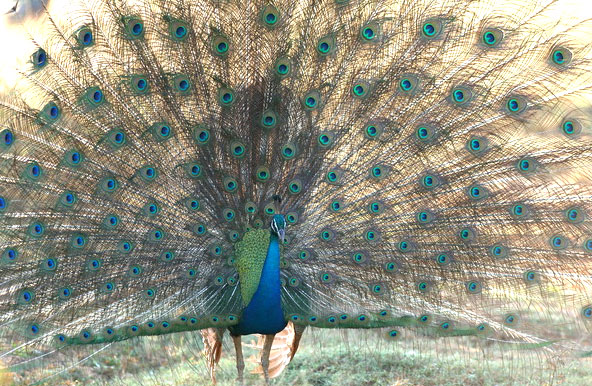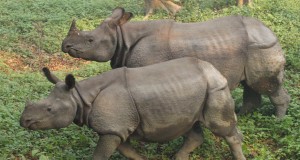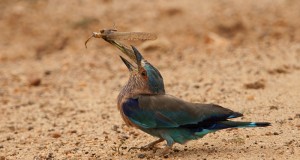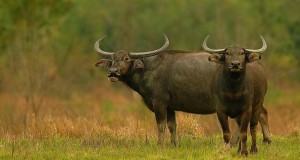Tucked away in the southeast corner of Sri Lanka, almost at the point where the south coast takes its upward curve to the east, is the Vala National Park, also known as the Ruhuna National Park, after the ancient name by which the south of Sri Lanka is still known.
The story of this national park goes back to the days of the great kingdom of Ruhuna or Rohana as it was then known. During that period, the area that is now the national park and a vast area surrounding it must have been fairly well developed and populated. The large number of ruins of ancient temples, monasteries and secular buildings that one sees, both within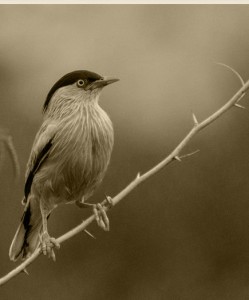 and without the park, bear testimony to this. At one corner of the large Vala plain that gives the park its name, is a fairly large tank, which is today entirely overgrown with tall lephant grass. Archaeologists have identified it as an ancient irrigation tank which supplied water to the surrounding paddy fields, including those in the Yala plain.As the glory of the Ruhuna kingdom faded, these areas were abandoned and the jungle took over. Many centuries later, under British rule, the area was declared a Residential Sportsmen’s Reserve. For a long time after that, hunters, mainly British, enjoyed controlled hunting here. Then on Feb. 25, 1938, the British Government declared it a National Park, thus giving total protection to its fauna and flora. Incidentally, it was on this same day that Wilpattu, on the west coast, was also given the same status.
and without the park, bear testimony to this. At one corner of the large Vala plain that gives the park its name, is a fairly large tank, which is today entirely overgrown with tall lephant grass. Archaeologists have identified it as an ancient irrigation tank which supplied water to the surrounding paddy fields, including those in the Yala plain.As the glory of the Ruhuna kingdom faded, these areas were abandoned and the jungle took over. Many centuries later, under British rule, the area was declared a Residential Sportsmen’s Reserve. For a long time after that, hunters, mainly British, enjoyed controlled hunting here. Then on Feb. 25, 1938, the British Government declared it a National Park, thus giving total protection to its fauna and flora. Incidentally, it was on this same day that Wilpattu, on the west coast, was also given the same status.
Another interesting feature in the history of this park is the ancient pilgrim route between Pottuvil and Kataragama that traverses it. Every year, from time immemorial, towards the latter part of July, pilgrims from Pottuvil, an east-coast town, and the surrounding areas start a trek that takes them to the festival at Kataragama, which lies to the west of the park and is the legendary abode of Skanda, the powerful god of war in the Hindu pantheon. The final leg of this route passes through the park, and the pilgrims who walk all the way are permitted to go through without the usual formalities. This practice has caused certain problems for the park authorities but the Government and the Department of Wild Life Conservation are compelled for two weeks each year to turn a blind eye on this disturbance in the even tenor of life in the park. During the 1900s, a man-eating leopard, later called the Pottana man-eater, appeared along this route and many pilgrims fell victim to it.
The Yala -plains”: Yala country is generally open, with large grassy areas — the “plains,” semi-desert-type brush and gnarled trees, often umbrella-shaped in branch formation; country that strongly reminds one of the African bush.
The term “plains” of Yala, is perhaps a misnomer. These “plains” are really large open glades of many acres that are grassy and dotted with thorny trees and scrub. Most have couple of water holes in them and are ideal places to see a variety of game and interesting birds. The three best known plains in the park are Yala, Buttawa and Uraniya.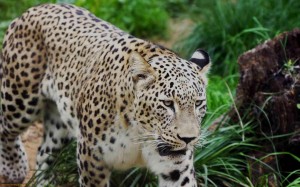
A characteristic feature of the park is the droopy malittan trees (Saratoga persica). They are evergreens and even under most severe drought conditions retain their freshness. Another plant that grows in great abundance is the beautiful Cassia auriculata, ranawara in Sinhala.
As one gets closer to the Menik Ganga (river of gems) which flows along the north- east border of the park, the dry brush country gives way to vegetation that is more luxuriant in growth and riverine in character. The banks of the river are dominated by the mighty pale-barked k u bu ks ( Terminaawl)rhjiuonas,ae spreading branches at certain spots form almost a canopy over the murmuring water. Another feature in the Yala scene is the large rocky outcrops strewn with boulders, favorite haunts of leopard and bear. The most famous of these is Vepanileniya , also known, and for good reason, as Leopard Rock. Three other giant megaliths are Jamburagala, Patanangala and Akasa Chetiya (also known as Elephant Rock due to its shape). This last one dominates the skyline and Portuguese and Dutch mariners of old used it as a landmark when sailing in these waters.
Elephant Land: Of all the national parks in Sri Lanka, Yala is undoubtedly the finest place to see a variety of species quickly and conveniently. Elephants are, of course, its speciality. Except during the very dry months (July — October), a visitor is bound to come across a number of these great creatures even on a half-day tour of the park. The best time to observe them is soon after the rains, when the fresh grasses have started to grow and the plains have begun to dry again. This period would be from about January to May. Soon after the rains the herds that had migrated northwards during the dry months return to the park and groups of them can be seen scattered over the plains, usually in the evening. Herds of up to 25 or more may be encountered, though this is not common. The usual size of a herd is eight — 10.
Other good places to observe elephants are at the numerous water holes around midday. It has been noticed that certain herds use the same water hole continuously for t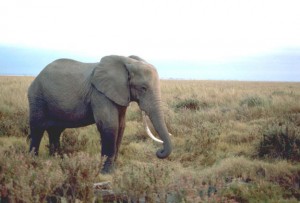 hree or four consecutive days, almost at the same time each day. So, it would be a good idea for a visitor who stays in the park for a few days to observe this and catch the herds at the right place at the right time. The tusker is undoubtedly the most magnificent and also the rarest animal in the Sri Lankan jungles today. Yet, not so long ago, the tusker roamed free and was a common sight before large-scale shooting took a heavy toll of their numbers. Yala could well be proud of its collection of tuskers. Observers have found their numbers in the park have increased during 1984 -1986. It is estimated that there are some 18 tuckers in the park, ranging from a two-foot (60-cm) calf to a nine foot (three-meter) giant. While this is very encouraging for the wildlife lover, park
hree or four consecutive days, almost at the same time each day. So, it would be a good idea for a visitor who stays in the park for a few days to observe this and catch the herds at the right place at the right time. The tusker is undoubtedly the most magnificent and also the rarest animal in the Sri Lankan jungles today. Yet, not so long ago, the tusker roamed free and was a common sight before large-scale shooting took a heavy toll of their numbers. Yala could well be proud of its collection of tuskers. Observers have found their numbers in the park have increased during 1984 -1986. It is estimated that there are some 18 tuckers in the park, ranging from a two-foot (60-cm) calf to a nine foot (three-meter) giant. While this is very encouraging for the wildlife lover, park
authorities have a difficult time keeping these tuskers within the park. Despite all their efforts, one of Yala’s prime tuskers was shot dead at the beginning of 1986 by poachers just outside park limits, causing a terrific outcry throughout the island. The tusks were recovered following some brilliant police work and the culprits were arrested.
Perhaps it would be fitting to make mention here of Raja, the greatest tusker to ever walk the plains of Yala. He was a majestic hull about nine feet tall and had a pair of great tusks symmetrically curving inwards. At one stage of his life Raja carried a fearful wound near his right armpit, but he totally recovered from this following the administration of a direct antibiotic from a “capture gun.” For many years after this Raja was seen in the park, often giving an exhibition of his terrific threat display to any visitor who came upon him unexpectedly at close quarters. When last seen, Raja carried a small wound at the top of his trunk, which nobody realized was a bullet wound, to which before long he succumbed. His skeleton was found within the park long after his death, together with the tusks which were about the heaviest recorded in a Sri Lankan elephant.
Most of the elephants at Yala are quite used to vehicles and are easily observed. However, visitors should keep at a fair distance and follow the instructions of their guide very strictly when among these great animals.
Leopard Country: The leopards at Yala are widely distributed and are see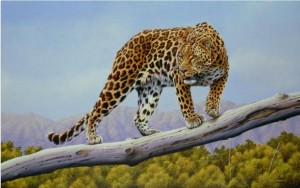 n in all sectors of the park. They however favor the more sandy and rocky areas. Ever since the park was established, the Vepandeniya rock has had a pair of resident leopards, perhaps successive generations. Very often visitors sec them sunbathing on top of the rock at dawn or dusk. During the midmorning and early afternoon hours, these cats usually go up the trees and are seen stretched out lazily on the branches of tamarind or wood apple. The leopard here tend to be rather shy and visitors should avoid making any sudden movement when they come across them.
n in all sectors of the park. They however favor the more sandy and rocky areas. Ever since the park was established, the Vepandeniya rock has had a pair of resident leopards, perhaps successive generations. Very often visitors sec them sunbathing on top of the rock at dawn or dusk. During the midmorning and early afternoon hours, these cats usually go up the trees and are seen stretched out lazily on the branches of tamarind or wood apple. The leopard here tend to be rather shy and visitors should avoid making any sudden movement when they come across them.
Except during the rains or after a heavy shower, visitors would be very lucky to see a hear. They are not uncommon but not often seen. The best time of the year to look for bear, when one is bound to come across two or three of them in a day, is late May and June, when their favorite fruits, the palu (Manilkara hexandra) and the veera (Drypetus sepieria) are ripe. Among the other animals which may be seen both in Yala and other parks in Sri Lanka are two species of monkey (the gray langur and the torque), four types of deer (samba , and the spotted, barking and mouse deer), buffalo and crocodiles. These last may be seen at all the water holes and along the banks of the Menik river. They are very wary and shy, unlike their more aggressive and larger estuarine counterparts found in the lagoons in the park.
Birds: Yala is a bird watchers’ paradise. One of the glorious sights of the park is the mating dance of the peacock. Between November and February even a few hours of watching will yield sights of a number of these displays. Among the numerous avian types found at Yala is the rare black-necked stork. It is feared that no more than a dozen survive on the island. When they are sighted, more often than not they are seen as a pair searching for prey in the Buttawa lagoon. Yala offers an interesting range of birds of prey and between September and May the migrants. Visitors who stay at the lodges near the river should keep a look-out for the elusive Indian paradise flycatcher and one of the world’s greatest songsters, the Ceylon shama. Two other common but intriguing birds widely seen are the Malabar pied hornbill and the hoopoe.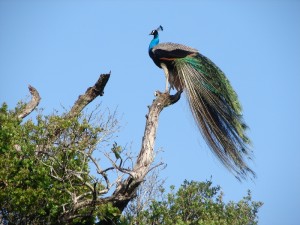
Yala is a well-organized national park with a total extent of 377 sq miles (976 sq km) of which only 52 (135 sq km) arc used for game viewing. The park is well roaded and throughout the year most of it can be covered by two-wheel drive vehicles. There are six lodges in the park: Mahaseelawa, Buttawa, Patanangala, Yala, Talgasmankade and Heenwewa. They are all superbly situated, two by the Menik river, two looking out to sea, and two overlooking jungle tanks. All these lodges are well-located for seeing animals, especially elephants who at times come up to the doorstep.
For the more outdoor types, Yala offers two campsites, both situated picturesquely by the Menik river. During the dry weather, when almost all the water holes are dry, one can see from these campsites groups of elephants coming down to the almost dry bed of the river and digging for water. The park is usually closed to visitors from August 1 to October 18 every year.

